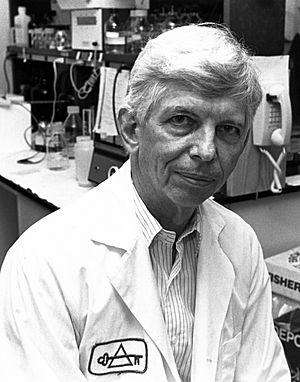Alfred G. Knudson facts for kids
Quick facts for kids
Alfred Knudson
|
|
|---|---|
 |
|
| Born |
Alfred George Knudson, Jr.
August 9, 1922 |
| Died | July 10, 2016 (aged 93) Philadelphia, Pennsylvania, U.S.
|
| Nationality | American |
| Alma mater | California Institute of Technology, Columbia University, California Institute of Technology |
| Known for | Knudson hypothesis |
| Awards | William Allan Award (1991) Lasker award (1998) Kyoto Prize (2004) |
| Scientific career | |
| Fields | Genetics, Medicine |
| Institutions | Stony Brook School of Medicine, MD Anderson Cancer Center, Fox Chase Cancer Center |
| Thesis | Histidine metabolism in liver (1956) |
| Doctoral advisor | Henry Borsook |
Alfred George Knudson, Jr. (born August 9, 1922 – died July 10, 2016) was an American doctor and scientist. He specialized in genetics and cancer research. Dr. Knudson is famous for his important idea called the Knudson hypothesis, which he shared in 1971. This idea helps us understand how changes in our genes, called mutations, can lead to cancer.
Early Life and Education
Alfred Knudson was born in Los Angeles, California, in 1922. He was a very dedicated student. He earned his first degree from the California Institute of Technology in 1944. He then became a medical doctor after studying at Columbia University in 1947. Later, he went back to the California Institute of Technology and earned his Ph.D. in 1956.
Career and Research
Dr. Knudson worked at many important medical and research centers. He was an Associate Dean at the Renaissance School of Medicine at Stony Brook University. He also served as a Dean at the University of Texas Health Science Center. From 1976 until he passed away, he was connected with the Fox Chase Cancer Center in Philadelphia.
Dr. Knudson is best known for his "two-hit hypothesis." This idea helps explain how some cancers, especially those that run in families, develop. A good example is retinoblastoma, a type of eye cancer.
Here's how his "two-hit hypothesis" works:
- We all get two copies of almost every gene, one from each parent.
- Some people are born with one copy of a special gene that isn't working correctly. This gene is important for controlling how our cells grow and divide. This first problem is like "the first hit."
- Later, by chance, the other copy of that same gene might get damaged in one of their cells. This second problem is "the second hit."
- When both copies of this important gene are damaged in the same cell, the cell can no longer control its growth. This can lead to cancer.
Dr. Knudson studied children with retinoblastoma. He noticed that children who inherited a risk for the cancer often had tumors in both eyes and at a younger age. Children who did not inherit this risk usually had only one tumor and developed it later in life.
His research showed that for cancer to develop, two "hits" or mutations are usually needed in a specific gene. If you inherit one "hit," you only need one more to develop cancer. If you don't inherit any "hits," you need two new mutations to happen in the same cell. These studies helped scientists understand tumor suppressor genes. Dr. Knudson called them "anti-oncogenes" because they help stop cancer from forming.
Honors and Awards
Dr. Knudson received many awards for his important work. These include the 1998 Albert Lasker Award for Clinical Medical Research, which is a very high honor in medical research. He also received the 2004 Kyoto Prize in Life Sciences. He was a member of important groups like the National Academy of Sciences.
Personal Life
Alfred Knudson passed away on July 10, 2016, at the age of 93, at his home in Philadelphia. His wife of 40 years, Anna Meadows, was also a respected doctor who specialized in treating cancer in children.
See also
 In Spanish: Alfred G. Knudson para niños
In Spanish: Alfred G. Knudson para niños

